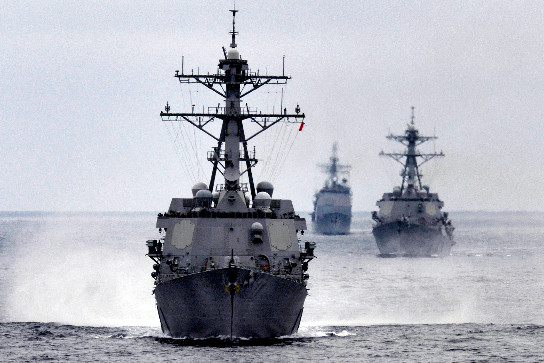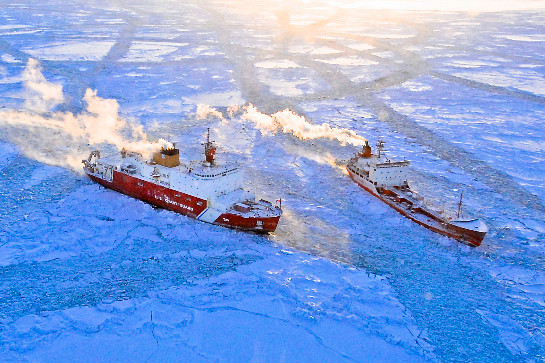 Three missile destroyers, photo courtesy of the US military.
Three missile destroyers, photo courtesy of the US military.
Challenges to the Navy in the Arctic Region
As the ice extent of the Arctic region continues to recede, the US Navy is tasked with maintaining security in a region of increasing importance. ASP has noted the Arctic’s strategic role for its energy resources, holding 22% of the world’s undiscovered recoverable hydrocarbon fuel, as well as holds promise as a transit route for ships. Commercially, the Arctic holds promise for tourism, fishing, and potentially even commercial shipping. Right now though, operation of vessels in the harsh conditions of the Arctic is extremely limited. The United States Navy should seriously consider the needs of its future Arctic mission.
Operating in the Arctic for a surface naval vessel presents a new series of challenges for the Navy. Surface ships must have reinforced hulls that can break through ice, superstructures must be designed to handle extreme ice buildup, pilots must navigate through unexpected ice formations, navigational charts can be inaccurate, there is a lack of logistical support, a lack of infrastructure to service ships in the region, and this all makes operations especially risky. All of these are challenges which the Navy must overcome if it seeks to increase its surface naval presence in the Arctic at any point in the future. Even beyond 2030, when Arctic summers are expected to be virtually ice free, windblown ice and extreme weather will require special capabilities for surface vessel operations.
Today the Navy has only limited plans for future Arctic operations. According to the US Navy Arctic Roadmap (2014-2030), the Navy’s air and submarine forces will be adequate to service the security needs of the United States in the near term. In this era of tight budget, this near term strategy will have to suffice; an assessment of the impact on climate change on Arctic naval operations done by the Center for Naval Analyses concluded that hardening surface vessels to operate in the Arctic could cost as much as $30 million per ship (the Navy currently has no ice hardened ships), and would only nominally improve operational capacity (only a couple months out of the year).
However, the Navy has acknowledged that the effects of climate change on the Arctic will create a serious need for an increased operational capacity in the region, and is instead focusing on training, infrastructure, navigation, and cooperation to enhance existing capabilities. How effective the US strategy will be in the Arctic is unclear at this point, but given that a naval presence in the region will be more and more important to securing US strategic interests it seems likely that the Navy will need to seriously consider how and when to expand its capabilities.







Sir,
What would you like to see the Navy do specifically do to expand its capabilities? How should the Navy respond to the increasing Russian threat to the region?
Thank you.